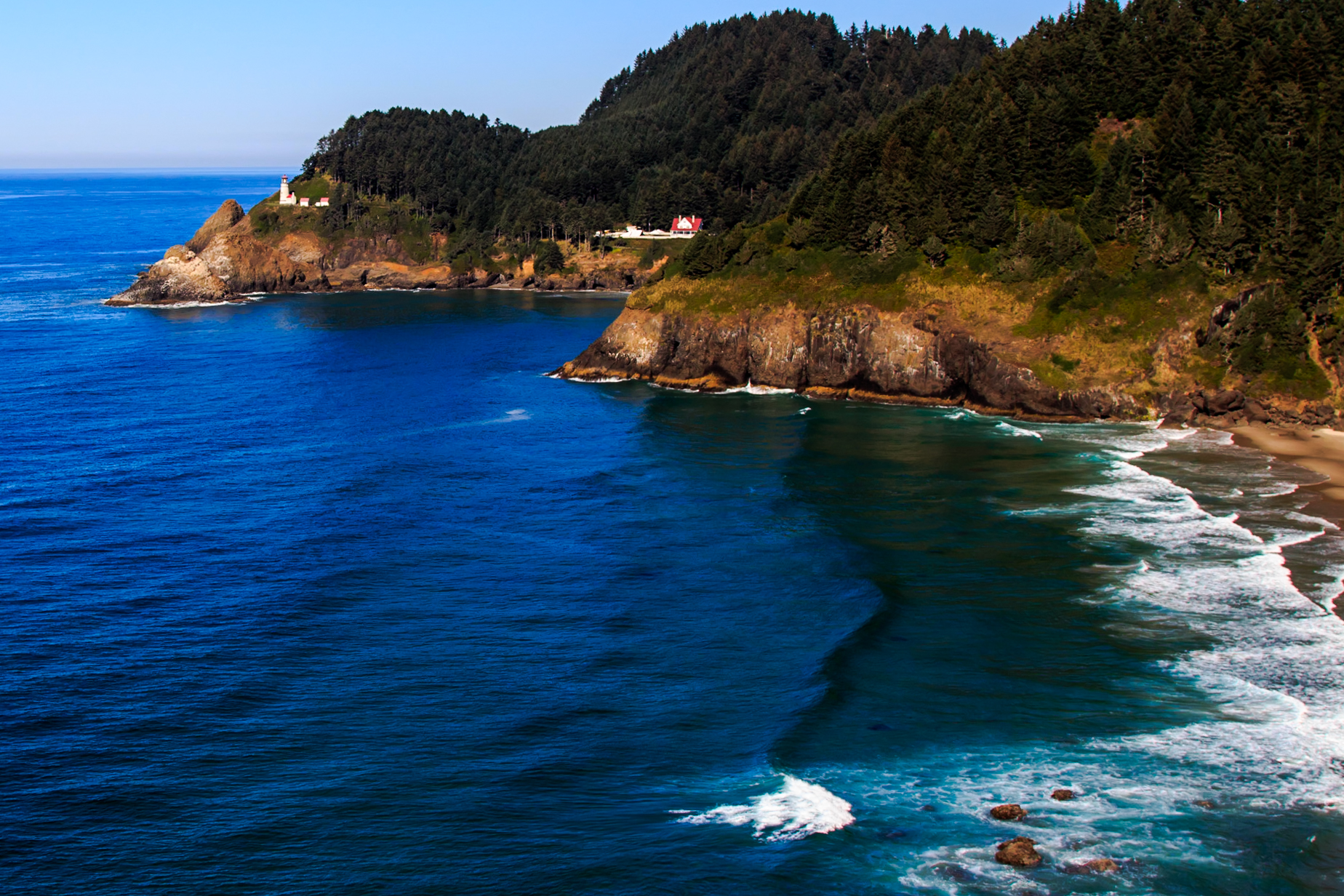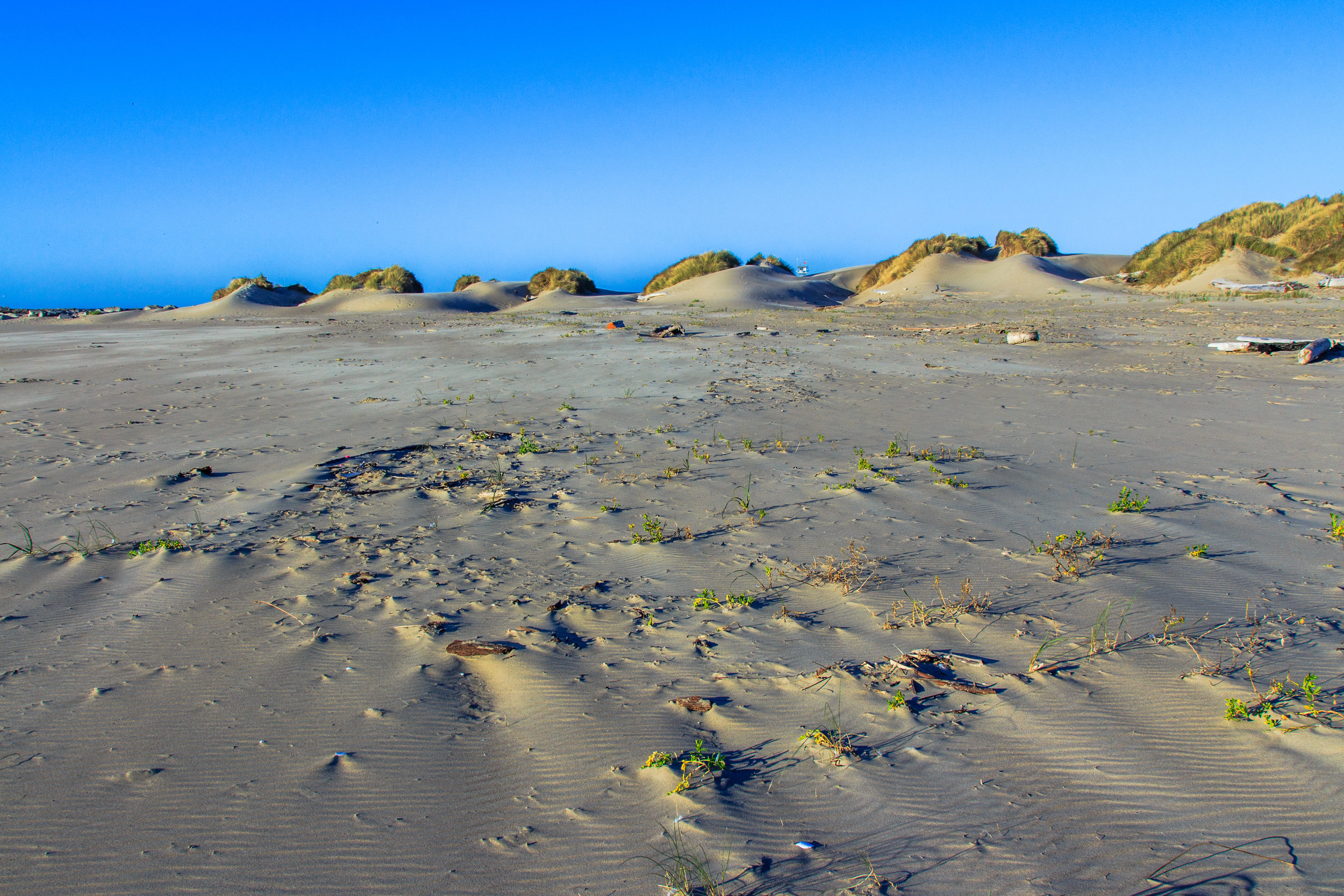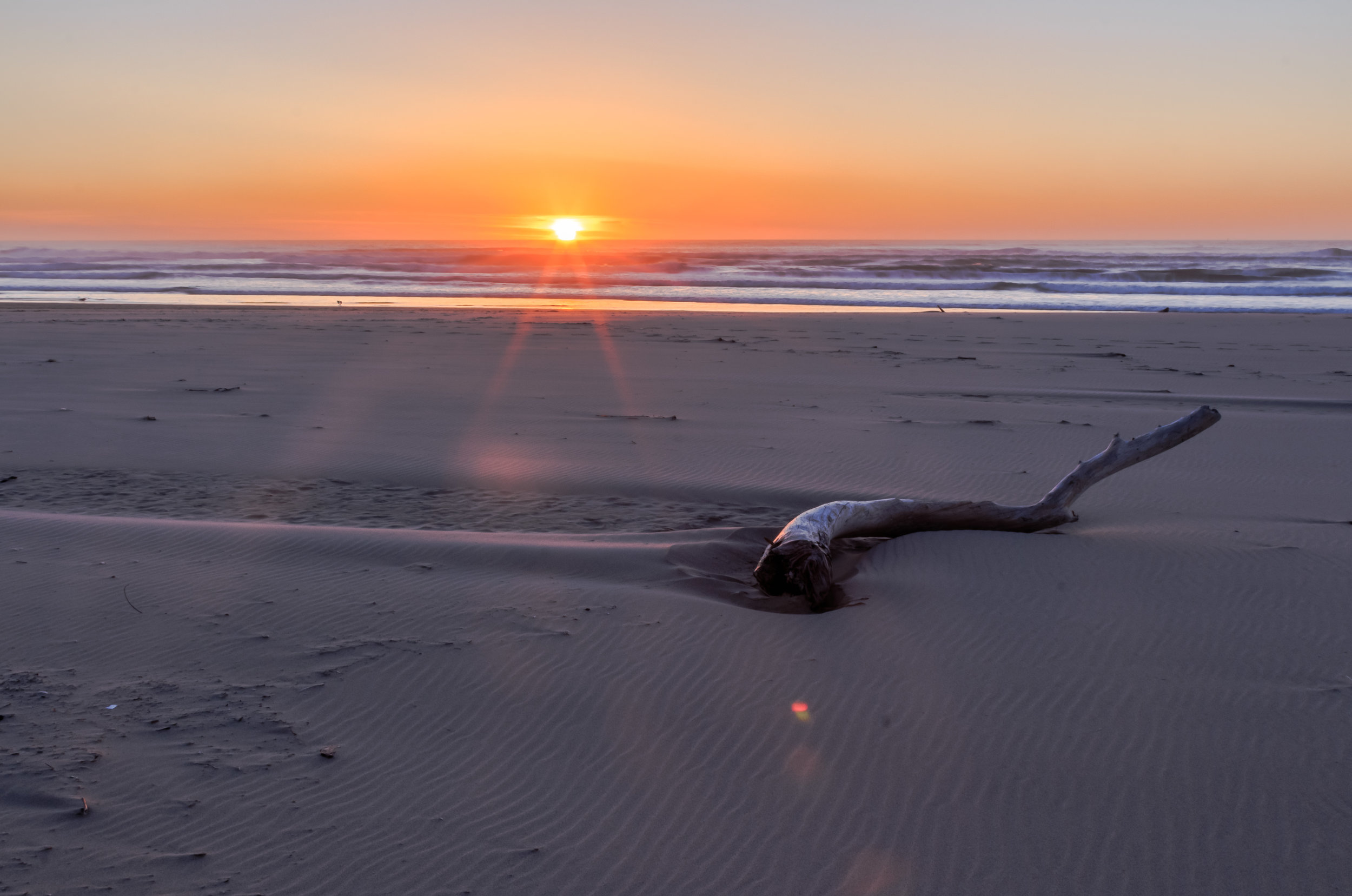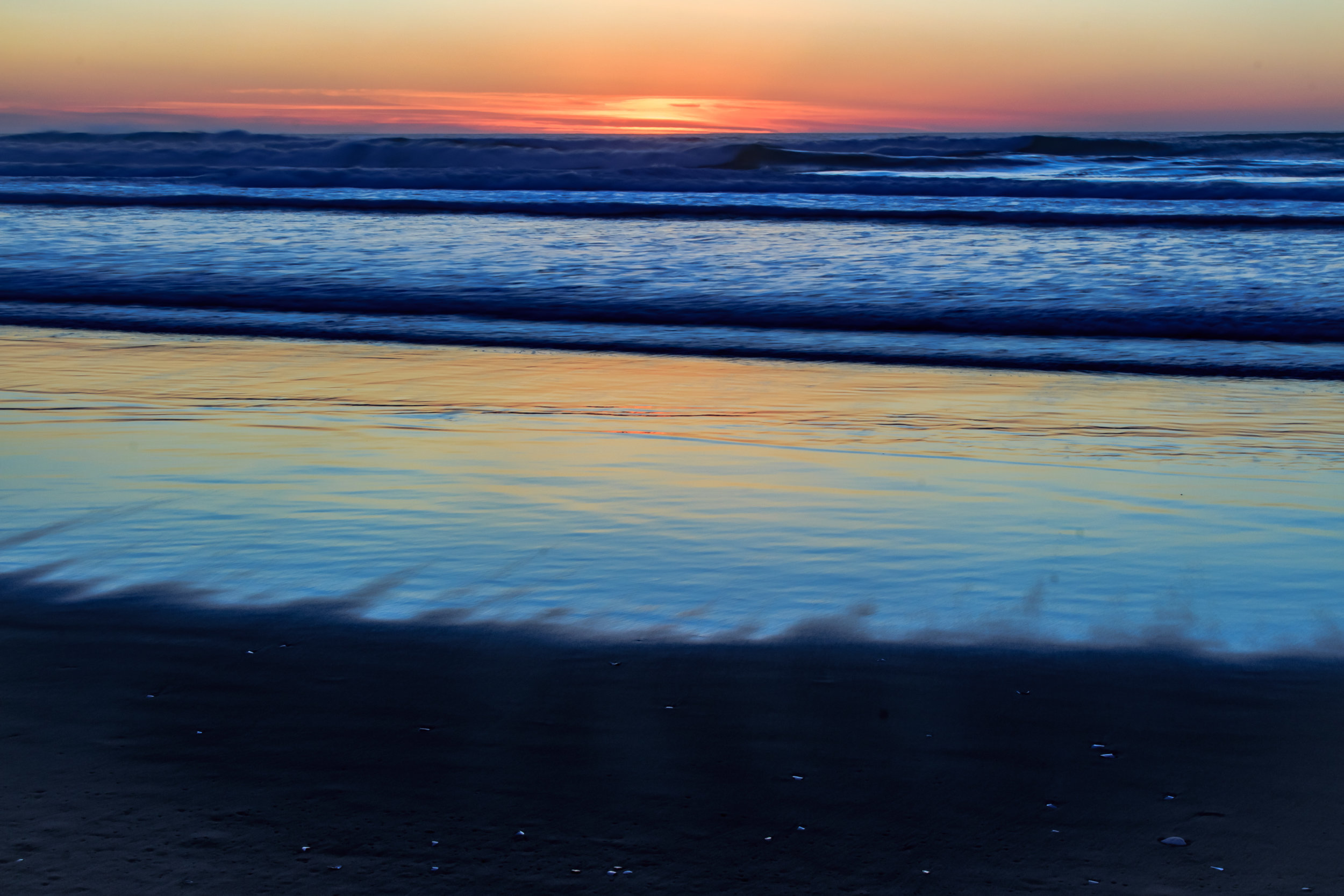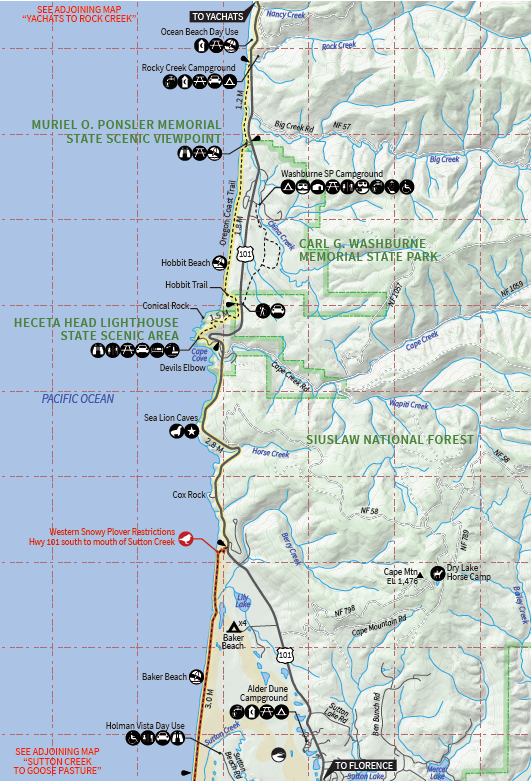Section 6:
Heceta Head to North Bend
Basics
Distance
68.2 miles
Elevation Gain
3,924 ft
Trail Type
One-way/Shuttle
Permit Needed?
No
Photos
Guide
Authored by Jesse Hazleton
Section 6 of the Oregon Coast Trail spans 68 miles along the central Oregon coast from Heceta Head to the city of North Bend. This section contains the iconic Heceta Head Lighthouse and the lesser known Umpqua River Lighthouse. The route makes its way through the heart of Florence and Reedsport and crosses the Siuslaw, Smith, and Umpqua Rivers along the way. Much of the section here consists of big, long, and flat sandy beaches that are flanked by rolling sand dunes. The area between Florence and North Bend contains the Oregon Dunes National Recreation Area, which is managed by the Siuslaw National Forest. The Oregon Dunes is the largest expanse of temperate costal sand dunes in North America. Jessie M. Honeyman State Park and Umpqua Lighthouse State Park are found just off the route, and beach camping is permitted on stretches that are outside of city limits. Note that there are significant western snowy plover nesting areas throughout Section 6. Please see the Tips section below for information on how to proceed through this sensitive habitat.
Heceta Head to Jesse M. Honeyman State Park
Your hiking adventure continues at the historic Heceta Head Lighthouse. After checking out the picturesque lighthouse and keeper's house, head down to the parking lot. Here you'll find Cape Creek Cove, which offers a small beach and scenic views of Heceta Head and the Cape Creek Bridge. Follow the road back to Highway 101 and use the below guidance for continuing south.
For those hiking the Oregon Coast Trail near Heceta Head, hikers should take note of a hazardous Highway 101 tunnel south of Heceta Head that passes through a landmark known as Devil’s Elbow. Currently there is no alternative hiking route other than Highway 101 for this section of the Oregon Coast Trail, however, due to the dangers posed to pedestrians, hiking through this tunnel should be avoided at all costs. Either arrange a private shuttle/taxi to travel through the tunnel or plan to pick up the Florence-to-Yachats Connector bus, which operates on a regular schedule Monday-Saturday. For those hiking south, the nearest stop for the Florence-to-Yachats Connector north of Heceta Head is located at Carl G. Washburne State Park, roughly 2.5 miles north of Heceta Head. Hikers picking up the bus at Carl G. Washburne State Park can request a drop-off at one of the safe Highway 101 pullouts south of the tunnel. For more information about the Florence-to-Yachats Connector including schedule, visit this page. The Florence-to-Yachats Connector bus is operated by River City Taxis in Florence. Additional inquiries for pick-ups/drop-offs along the route can be made by calling River City Taxis at (541) 997-8520.
While we strongly urge use of shuttle for the tunnel section of Highway 101, if you do decide to walk, use extreme caution on this section of the highway; the tunnel that has no shoulder for pedestrian crossings. Just before the tunnel you'll see a crossing button to alert vehicles of your presence in the tunnel. If you choose to pass through the tunnel on foot against the advice of this guide, ensure use of this button. Sections of this part of the highway also have narrow shoulders for pedestrians. Continue to use caution and stay alert to vehicles passing by. Soon you'll find a viewpoint that offers a stellar view of the lighthouse perched on the cliff of Heceta Head. Shortly after the viewpoint you’ll pass by the Sea Lion Caves. This area is a privately owned wildlife preserve and happens to be the largest sea cave in the United States. Access to the cave requires purchasing a ticket. There are also a few paths to platforms that offer views up and down the coastline. Once you've finished at the Sea Lion Caves, continue along the highway as it returns closer to sea level and until it crosses Berry Creek. Exit 101 to the right here and follow the creek to the beach. Cross over the dune and head down to Baker Beach, and be aware that this area includes western snowy plover habitat. Please see the Tips section above for detailed information. This area is mostly secluded, but you may run into the occasional horseback rider. Continue along the beach for about 4.5 miles until you reach the North Jetty of the Siuslaw River. Climb up onto the jetty itself and head east to the parking area.
From here, take Jetty Road to Rhododendron Drive. Head south on Rhododendron to Kingwood Road to Highway 101. Here you'll have the option to continue along the route by crossing over the Siuslaw River Bridge or to head down to Florence’s Old Town along the banks of Siuslaw River. Old Town is a great place to recharge and enjoy what Florence has to offer. After crossing the Siuslaw River Bridge, continue along Highway 101 until you reach South Jetty Access Road. If you are reaching this point at the end of your day, consider spending the night at Jessie M. Honeyman State Park. Like most coastal state campgrounds, this park has hiker/biker tent-only sites for a small nightly fee. These sites are distributed on a first-come, first-served basis. Access the park by continuing on Highway 101 for about 2 miles. Keep in mind that the next section of the trail is long and remote, and amenities are limited to non-existent in this section. Be sure to carry plenty of water and food. When you are ready to continue, make your way back to South Jetty Access Road and head west.
Oregon Dunes National Recreation Area – South Jetty Siuslaw RIver to Horsfall Beach
South Jetty Access Road turns into Sand Dunes Road and wanders into the Oregon Dunes National Recreation Area. Portions of the sand dunes are a mecca for off-highway vehicle recreation, yet large sections are reserved for non-motorized recreation. From Sand Dunes Road, access the beach at South Jetty Beach 1 Day Use Area. The trail follows the beach here for the next 15 miles. You’ll be sharing the beach with OHVs for the first 5 miles until you reach the Siltcoos River, which is the first water crossing you’ll run into along this beach section. There is an access point here that takes you to a day-use parking area and a number of nearby Forest Service campgrounds. This will be your last chance to access any sort of amenities for quite some time along the trail. The Siltcoos River is best forded during low tide, but it can be done anytime by taking off your shoes and rolling up your pants. A similar crossing exists a few miles down the beach at Tahkenitch Creek. A few more miles down the beach and you’ll reach the Three Mile Creek Beach Access. If you've made arrangements with Winchester Bay Charters to be ferried across the Umpqua River (call Winchester Bay Charters at 541.361.0180 at least 48 hours in advance to set up a specific meeting time May through September), continue south along the beach to the designated pick up spot. Missing the boat at the appointed time means a considerable reroute by foot, so be conservative when making your ferry arrangements.
If you opt to skip the ferry option and continue on foot, or miss your pick-up, look for the neon green sign with the number 116. You’ll find a small, unmaintained parking lot and Sparrow Park Road. This road is an unmaintained county road, and there is a possibility of finding backcountry campsites along it or on the previous section of beach. Follow Sparrow Park Road for another 1.3 miles until it turns south and then very sharply north and inland. At this point continue east on the dirt levee road along the bank of the Umpqua River until you reach Highway 101. Head south along the highway through the small town of Gardiner. You'll need to continue along Highway 101 through Reedsport for about 4.6 miles until you reach Salmon Harbor Drive. Head west through the small community of Winchester Bay. While technically off the route, the Umpqua River Lighthouse is a short detour worth checking out. The nearby state park campground of the same name has the typical coastal state park amenities, including hiker/biker campsites, and there is a county campground in Winchester Bay. At this point, be prepared for another long stretch of beach.
Access the beach via Umpqua Beach Day Use Area just off of Salmon Harbor Drive. There are numerous parking areas for pedestrian beach access as well as OHV staging. OHV travel is permitted south of Tenmile Creek, so expect to share the beach with OHVs for the latter 6 miles of this 14-mile stretch of beach. This section of beach is also quite remote. There is no access point for amenities in this section, though beach camping is permitted here, and hikers can take the John Dellenback Dunes Trail to Eel Creek Campground, which is not an OHV campground. Continue along the beach until you reach Horsfall Beach. Horsfall Beach Campground is another OHV staging area, but hikers may be more comfortable at Bluebill Campground jurther up the Horsfall Road toward Highway 101. Potable water and restrooms are available onsite. It also marks the southern boundary of the Oregon Dunes National Recreation Area and the end of this section of the OCT.
To continue exploring Oregon Coast Trail by section, check out these online guides:
Oregon Coast Trail Section 1: Fort Stevens State Park to Oswald West State Park
Oregon Coast Trail Section 2: Oswald West State Park to Tillamook River Bridge
Oregon Coast Trail Section 3: Tillamook River Bridge to Bob Straub State Park/Pacific City
Oregon Coast Trail Section 4: Bob Straub State Park/Pacific City to Otter Rock
Oregon Coast Trail Section 8: Bandon to Humbug Mountain State Park
Oregon Coast Trail Section 9: Humbug Mountain State Park to Pistol River
Maps
Tips for hiking the Oregon Coast Trail
The Oregon Coast Trail offers hikers an opportunity to experience the beauty of Oregon’s coastal landscapes and ecosystems in an intimate and continuous way, and it passes through fragile environments. Your awareness of a few additional items can enrich your overall experience on the OCT and help minimize your impact on delicate environments along the way.
Before departing on your hike, learn the Leave No Trace Seven Principles so that you can practice them while you are out on the trail. The more that people incorporate Leave No Trace into their decisions and habits, the better the outdoor experience will be for everyone.
Learn about Oregon’s five unique marine reserves. Marine reserves are areas that have been set aside for study, research, and conservation; it is illegal to remove any marine life from a marine reserve, and they are also protected from any development. Marine protected areas, which are often adjacent to reserves, allow some fishing and development. Marine reserves are wonderful areas to observe wildlife and take in Oregon’s beautiful coastal scenery. Fortunately, Oregon’s marine reserves couldn’t be more accessible than when hiking the OCT. From north to south they include:
The islands and sea stacks along the coast are protected as part of Oregon Islands National Wildlife Refuge. They provide crucial nesting habitat for seabirds and pupping/resting sites for seals and sea lions. All seabirds and marine mammals are protected by federal law and are sensitive to human disturbance. For this reason, all islands and sea stacks are closed to public access year round.
Portions of the trail meet the ocean's waterline and may only be passable at low tide. Excercise caution and safe judgement; wait for appropriate tidal conditions in these areas, and always watch for sneaker waves.
Pay special attention to areas signed and posted as snowy plover habitat. A handful of Oregon’s beaches and estuaries provides critical habitat for the western snowy plover, a species that the U.S. Fish and Wildlife Service listed as threatened in 1993. The breeding season for the western snowy plover is from March 15 to September 15, and during this time it is imperative to avoid potential nesting locations in dry sand beach areas. Dogs, kites, bikes, and vehicles are all prohibited from March 15 to September 15, and walking is only allowed on hard-packed wet sand. Please do your part to help this threatened species survive by complying with posted restrictions and completely avoiding closed areas. There are designated snowy plover areas from Fort Stevens to Floras Lake, and hikers should be aware of their locations. To learn more, be sure to check out these snowy plover resources:
The Oregon coast is generally a very dog friendly location, and dogs are allowed on most beaches, state parks (when on a leash) and other coastal public lands. However, there are specific times and locations when dogs are not permitted in certain areas, such as beaches and estuaries identified as snowy plover habitat during nesting season. Please pay attention to posted signage and respect times and areas where dogs are prohibited.
For those interested in hiking the OCT in sections, or even just accessing the trail for day hikes, take note that recreation fees and passes are required at several federal recreation sites. If you will be parking at one of the state or federal fee area recreation sites, make sure to pick up the applicable recreation pass such as an Oregon Coast Pacific Passport.
Risks of hiking road sections
Although officially designated as a trail over 40 years ago, the OCT is an ongoing project and not yet a single continuous hiking trail. Gaps in the trail, usually caused by rivers, bays, or rocky headlands, require hikers to walk along busy roads (often U.S. Highway 101) that are not designed for pedestrian use. Oregon Parks and Recreation Department and other public and nonprofit agencies, including local cities and counties along the Oregon coast, are working to eliminate these breaks by establishing trails to connect trail segments and beaches.
In 2016, the Oregon legislature enacted legislation requiring OPRD to complete an action plan that will identify steps needed to complete the trail. This planning effort will identify key stakeholders and document the current status of trail completion, evaluate and assess alternatives for completing trail segments, and seek funding to complete new trail sections.
Until the trail is completed, OCT hikers will have to decide whether they choose to walk along the shoulder of the highway that is, in fact, currently an official part of the trail. It is important for OCT hikers to understand the risks of walking along the highway portions of the OCT. The most prevalent dangers are being hit by a vehicle or being struck by debris kicked up by or flying out of a passing vehicle. In addition, some highway sections along the Oregon Coast Trail are longer and more difficult than others. These highway sections are detailed in each section's guide.
Public safety is of the highest concern for the Oregon Coast Trail Foundation, and we do not advise walking along roads without a designated pedestrian path. We support utilizing other modes of transportation to connect the trail and beach sections such as public transportation, private shuttle or taxi, biking, ferry, or completing the Oregon Coast Trail in hiking sections to avoid the highway altogether. Two great resources for finding alternative transportation are Google Transit (Google.com/transit), Visit The Oregon Coast (visittheoregoncoast.com/transportation/), and an internet search for taxis or other transportation alternatives in the town nearest to the trail break. There are also ferry services available to cross the Nehalem River, Tillamook Bay and the Umpqua River, and these will greatly reduce the amount of highway miles one must walk. Note that ferry boats do run on a regular schedule and must be reserved in advance. More information on each of these ferries is found in Section 2 and Section 6.
This guide provides information needed for hikers who do choose to walk the trail in its entirety, including those portions along the highway. We urge those hikers to exercise caution to ensure a safe and enjoyable hike on the OCT.





